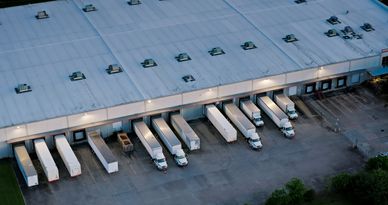I have learned that business lunches are a great opportunity to find out from others what is happening in their respective markets (I…

I have learned that business lunches are a great opportunity to find out from others what is happening in their respective markets (I used to think they were just about drinking and trying to impress people). When the powerful combination of listening and asking questions with intent are combined, I have discovered a lot can be found.
Lately, it seems, investors have been moving their appetite — quietly but decisively — toward three sectors: logistics, purpose-built student accommodation (“PBSA”), and AI (no surprise there). Meanwhile, life sciences, the crown jewel of the post-pandemic era, appear to be losing a bit of its shine.
What’s going on? Let’s look at it — without the jargon, without the hype.
1. Logistics: the new backbone of the modern economy
Logistics used to be the unglamorous part of the economy — the warehouses on the M1, and the last-mile depots you only needed to visit when a delivery was missed. Now? It’s the quiet superstar of the real asset world that exists outside of the digital system.
Investors have woken up to the fact that the modern economy runs on logistics. Every click, every grocery order, every next-day delivery depends on a web of industrial and distribution assets. Take Ocado – a logistics company that is so well advanced that it can onboard any premium grocery provider and package it up to customers – this capability is highly valuable.
Amazon is, of course, the king of logistics and is so far advanced no other provider comes close to the level of convenience and dependability it offers its customer base, making it the second-largest revenue generator in the world at $638 billion (Walmart is the first with $681 billion).
And unlike many sectors, logistics offers what investors crave right now:
- Predictable cash flows
- Structural demand (thank you, e-commerce)
- Assets that can flex with new tech — automation, drones, AI routing
It’s not flashy. But it’s stable, scalable, and future-facing. In this climate, that’s gold.
There has been a shift in investor sentiment — both emotional and financial — in response to this new permanent state of uncertainty. That shift is firmly toward sustainable, predictable returns.
2. Student accommodation: resilience meets reinvention
Then there’s PBSA — once seen as a niche play, now firmly in the mainstream. Why? Because it ticks every box of post-pandemic investing: steady demand, demographic growth (largely driven by migration), and predictable income.
University enrolments are steady despite changes in immigration policies, which have restricted international student numbers. Nonetheless, international students are returning, with a 32% increase in Q1 2025. And supply? Still nowhere near keeping pace – estimates from CBRE see a shortfall of 600,000 beds.
But here’s the twist — investors aren’t just chasing rent yields. They’re looking at placemaking: better design, mental health support, sustainability. Student housing is evolving into a kind of “modern micro-community.” It’s not just about a bed — it’s about belonging. And that emotional layer, ironically, makes it an even more investable asset class. PBSA also outperforms HMOs and university halls of residence in terms of facilities and prime locations.
So, it’s not surprising that lenders are climbing over each other to give borrowers what they need in this market. The same is true of new, high-quality, modern office spaces in central London where lender competition is also fierce.
You see, the market is fast moving and fickle, whilst a few years ago everyone stopped investing in the city because the sentiment was everyone is going to work from home and no one will be in the office – now, that pause in investment, coupled with the reality that people are coming back to the office because we are social beings – means supply and demand aren’t aligning.
Great news if you were ahead of the curve.
3. AI: the magnet for modern capital
No surprise here — AI remains the gravitational centre of global capital flows. But the mood has shifted from hype to hard questions. Investors are no longer just dazzled by the “AI revolution.” They’re asking: what’s the business model? Where’s the unique play? It’s not enough to simply use AI and label your business as ‘AI-enabled’ — and who’s regulating this space?
Still, the appetite is huge. AI touches every industry — logistics, finance, healthcare, defence — and the companies that can apply it practically (not just theoretically) are drawing serious attention. The investment in talent from the likes of Meta, OpenAI, and Google is eye-watering, as is the amount of attention it’s attracting from investors.
Think of it like electricity in the early 1900s — everyone knew it was the future, but few knew how to use it profitably. That’s the phase we’re in now.
4. Life sciences: from too hot to trot to hesitant
And then there’s life sciences — the one sector that feels like it’s been left standing when the music stopped.
Just a couple of years ago, lab space was the new luxury real estate. Funds were pouring in. Everyone wanted a slice of “the next Cambridge Biomedical Campus.” The golden triangle made up of Oxford, Cambridge and London was booming with investment.
But reality has kicked in. Construction costs soared. Occupier demand plateaued. And crucially, the repayment burden for pharmaceutical companies dramatically increased to 23% in the UK, compared to 7% on the continent. This leaves many early-stage firms are still burning cash without clear paths to profitability and no exits plans. And the wider macro picture hasn’t helped — rising rates, higher debt costs, and investors becoming more risk-aware.
According to the Association of the British Pharmaceutical Industry – Foreign direct investment into UK life sciences has fallen dramatically — dropping by more than half between 2017 and 2023. None of this reflects a lack of scientific excellence; it reflects a commercial environment that does not give companies enough confidence to commit their resources.
Right now, capital is craving clarity and cashflow, not complexity and long timelines.
The bigger picture: from promise to pragmatism
Across all sectors, one pattern stands out: the market is maturing emotionally. Investors aren’t chasing novelty anymore — they’re chasing stability, structure, and proven track records. Sectors like logistics and PBSA offer resilience. AI offers relevance. Life sciences? Tremendous promise — but too many unknowns for now.
In other words, capital is following confidence.
The epilogue
Markets move in cycles, but sentiment moves in waves, fast emotional ones — and right now, the wave is heading toward sectors that feel real, reliable, and ready. Just like fashion, what’s hot one season isn’t the next — but the trend will return; it just might take 5–10 years.
In this case, that may well be true for life sciences investment. If you’re building, funding, or advising in these spaces, the opportunity isn’t just to chase yield — it’s to tell the story of resilience in a way that connects emotionally with investors. Because behind every investment decision, there’s a simple question:
“Where do I believe the future will deliver financially?”
And the sectors that can answer that — clearly, credibly, and humanly — will win the next wave of capital.
If you’re building, funding, or advising in these spaces, the opportunity isn’t just to chase yield — it’s to tell the story of resilience in a way that connects emotionally with investors.

/Passle/MediaLibrary/Images/2025-07-29-10-10-52-089-68889e2c4319fe26b8a3cc43.jpg)
/Passle/MediaLibrary/Images/2025-10-14-08-37-57-574-68ee0be5d14ff766184f6ba8.png)
/Passle/611cdc8bfac91e0bc4343915/SearchServiceImages/2025-10-13-13-54-39-236-68ed049fae4aedbe7118722e.jpg)
/Passle/MediaLibrary/Images/2025-10-07-08-51-48-589-68e4d4a4d1773c31c9538ef7.JPG)